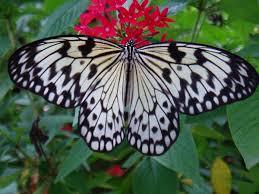October 24, 2019 Ryukyu Shimpo
On October 23, the “Okinawa Prefectural Butterfly” Selection and Advisory Committee held their second meeting at the prefectural office to decide on a prefectural butterfly that represents Okinawa Prefecture.
The committee decided on the Tree Nymph butterfly as their final candidate. The plan is to conduct a survey to collect public input next month.
Once the committee receives approval from Governor Denny Tamaki, the Tree Nymph butterfly will officially become the prefectural butterfly during this fiscal year.
This is the second case of a prefectural butterfly being established. The first being Saitama Prefecture.
According to a representative of the prefecture, candidates were evaluated based on four aspects, which were: 1) representation of a rich natural environment, 2) familiarity and popularity, 3) utilization for educational purposes, and 4) academic and and biological viewpoint (scarcity and uniqueness).
Tree Nymph butterflies are found throughout the entire prefecture, such as Okinawa, Miyako, and Ishigaki Islands. According to the representative, “It was unanimously decided since (the tree nymph butterfly) satisfies the selection criteria.”
Besides Committee Chairperson Kuniharu Miyagi, a total of four committee members from subjects, such as ecology, entomology, and forest ecology, attended the meeting.
In preparation for the establishment of a prefectural butterfly, the Prefectural Residents for Establishing Okinawa’s Prefectural Butterfly Association held a symposium in hopes of gathering momentum.
In 2017, the Tree Nymph butterfly came in first place among five candidates during the “Haberu General Election.”
Prefectural Residents for Establishing Okinawa’s Prefectural Butterfly Association Chairperson and Doctor of Agriculture Yasuhiro Ohshiro said, “Most of the prefectural residents were in favor of the Tree Nymph butterfly during the general election.
It must mean that it’s just that widely known and familiar. With this in mind, it would be nice if people pay more attention to other rare species as well.”
(English translation by T&CT and Chelsea Ashimine)





